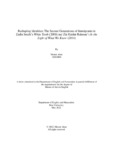| dc.contributor.advisor | Azim, Firdous | |
| dc.contributor.author | Alam, Musrat | |
| dc.date.accessioned | 2022-11-15T04:10:27Z | |
| dc.date.available | 2022-11-15T04:10:27Z | |
| dc.date.copyright | 2022 | |
| dc.date.issued | 2022-05 | |
| dc.identifier.other | ID: 18263004 | |
| dc.identifier.uri | http://hdl.handle.net/10361/17563 | |
| dc.description | This thesis report is submitted in partial fulfillment of the requirements for the degree of Masters of Arts in Teaching to Speakers of Other Languages, 2022. | en_US |
| dc.description | Cataloged from PDF version of thesis. | |
| dc.description | Includes bibliographical references (pages 40-44). | |
| dc.description.abstract | How identities are reshaped and reconstructed through the influence of history and the
ways in which the second generation of immigrants react and adapt within the transnational
space is the central focus of this dissertation. It is well to remember that these adaptations and
transformations are always of a fluid nature. I use the term ‘transnationalism’ to associate it
with migration and to include the movement of people, goods as well as ideas and ideologies,
beyond the borders set by nation-states. Transnational studies look at deterritorialized regions
and subjects where there is a continuous process of reshaping identities and new
subjectivities are created. Transnational studies combine the debate on origins as it borrows
from post-colonial studies but goes on to look at the ways in which these roots and histories
are put through new processes of globalization. This thesis looks at two novels to
demonstrate this process: White Teeth (2000) by Zadie Smith and In the Light of What We
Know (2014) by Zia Haider Rahman. These two novels represent England as the hub for the
interconnectivity between generations of immigrants who now live in the transnational city
space which is tainted with the colonial past. The novel White Teeth (2000) focuses on the
Caribbean community with the inclusion of Bangladeshi characters named Millat and Majid:
who go through the continuous reshaping of identities within the multicultural flux. On the
other hand, Rahman’s novel portrays South Asian characters (represented by Zafar, who is
from Bangladeshi and the unnamed Pakistani narrator) and focuses on their subjectivities as
they are reshaped and influenced by transnational processes. With the examples from the
novels, this dissertation also focuses on the subtle changes in the timeline of transnationalism
through the characters’ identity reformation. | en_US |
| dc.description.statementofresponsibility | Musrat Alam | |
| dc.format.extent | 44 Pages | |
| dc.language.iso | en_US | en_US |
| dc.publisher | Brac University | en_US |
| dc.rights | Brac University theses are protected by copyright. They may be viewed from this source for any purpose, but reproduction or distribution in any format is prohibited without written permission. | |
| dc.subject | Transnationalism | en_US |
| dc.subject | Migration | en_US |
| dc.subject | Identity | en_US |
| dc.subject | Immigrants | en_US |
| dc.subject | Cultural displacement | en_US |
| dc.subject | History | en_US |
| dc.subject | Postcolonialism | en_US |
| dc.subject.lcsh | Postcolonialism in literature. | |
| dc.subject.lcsh | Literary form--History--20th century. | |
| dc.title | Reshaping identities: The second generations of immigrants in Zadie Smith’s White Teeth (2000) and Zia Haider Rahman’s In the Light of What We Know (2014) | en_US |
| dc.type | Thesis | en_US |
| dc.contributor.department | Department of English and Humanities, Brac University | |
| dc.description.degree | M. in English | |

